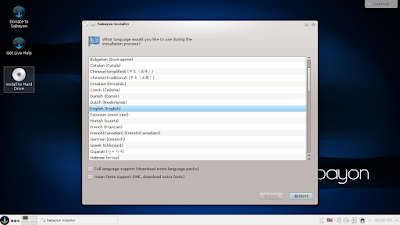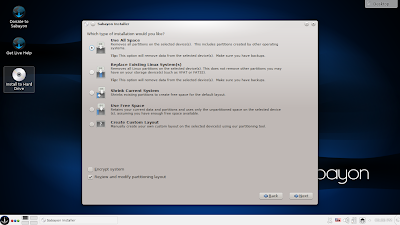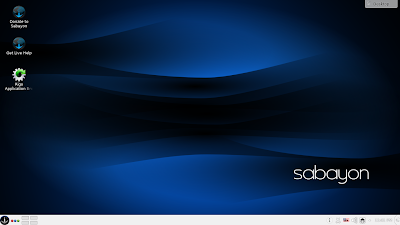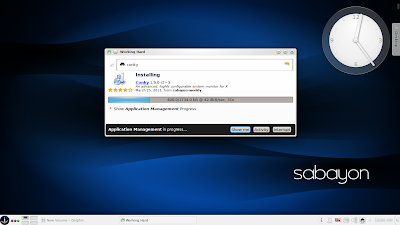Let me begin this way, I am a great admirer of Sabayon for quite sometime. This Italian distro is based on Gentoo Linux and provides an enviable ensemble of pre-installed applications which just works out of the box. Those who are scared of Gentoo, Sabayon can be a good starting point. Apart from being based on one of the most popular Linux operating systems, one of the greatest USPs of Sabayon is it's aesthetics. It comes with a very professional dark blue theme with application interfaces tweaked to match it. I haven't seen many Linux distros doing it, to be honest.
Sabayon, in every release, gives a ready to use Gentoo Linux based operating system with pre-installed applications and multimedia codecs. It has a rolling release cycle with around 3 releases every year. For example, in 2012, Sabayon 8, 9 and 10 were released in Feb, Jun & Sep 2012 respectively. The Apr'13 release is named differently as 13.04 rather than Sabayon 12 (Sabayon 11 was released in Feb'13). Anyway, apart from the change in nomenclature, rest of the things haven't changed much in Sabayon 13.04. In Fabio Erculiani's words
Installation
Installation is quite easy and takes about 15-20 minutes of time. Questions asked are the usual ones, viz. language, location, keyboard type & language, hard drive where to install the OS, root password and finally, user ID creation. The stylist interactive installer works well and should be easy for even a Linux novice. Installation has not changed much over last 4 releases or so for Sabayon.
Desktop
Sabayon 13.04 KDE has the pure KDE 4.10.2 interface without any tweaking but with a changed dark blue wallpaper. Interfaces of applications like LibreOffice are tweaked to gel with the dark blue theme. It looks good and professional. Minute detailing is one of the features of Sabayon and it is evident from 13.04 release. KDE desktop itself is customizable and loaded with widgets. I added a clock and a conky to the desktop to add the glamor.
Further, there are some really good looking wallpapers as well, to choose from.
Dolphin 2.2 is the default file manager. Dophin is one of the most powerful file managers and it works well in Sabayon. It will show you the files you accessed at different point in time, which may come really handy in case you access/create a lot of files daily.
Touchpad & Wifi recognition
Hardware recognition is, as usual, good with Sabayon 13.04. It could recognize my touchpad, wifi, display and sound card immediately without any issue.
Applications
Sabayon is loaded with utility pre-installed applications, viz.
Repository
Sabayon Linux sources its applications from the Gentoo repositories. Gentoo has a reasonably rich repo and you can get most of the commonly used applications. I was impressed with Sabayon's Rigo application browser. It is actually all-in-one interface as far as updates and applications are concerned. You can browse and install desired applications via Rigo. Simple but extremely functional.
I installed conky, Firefox and some other applications via Rigo without any issue.
Performance
Despite a reasonably rich interface with subtle effects and animations, Sabayon consumes moderate RAM and CPU. With task manager running, it consumed about 380 MB of RAM and 1-10% CPU. Actually Sabayon 11 performed better on my machine when I tested in Feb'13. If I compare it to other notable KDE distros, Sabayon consumes a bit more resources than say, a Mageia or Kubuntu or Linux Mint. All the results given below are based on my testing on Asus K54C and under similar conditions.
-->
 |
| From Sabayon 13.04 KDE http://mylinuxexplore.blogspot.in |
"Sabayon 13.04 is a modern and easy-to-use Linux distribution based on Gentoo, following an extreme yet reliable rolling-release model. This is a monthly release generated, tested and published by our build servers containing the latest and greatest collection of software available in the Entropy repositories. Linux kernel 3.8.8 with BFQ iosched and ZFS, GNOME 3.6.3, KDE 4.10.2, MATE 1.6, Xfce 4.10, LibreOffice 4.0, production-ready UEFI support and experimental systemd support are just some of the things you will find inside the box"I tried out the KDE flavor of Sabayon 13.04 and will take you through my experience in this review. I downloaded the 32-bit ISO, about 2.3 GB in size and installed it in my Asus K54C with Core i3 2.2 Ghz processor and 2 GB RAM. Imagewriter (available in Linux Mint) works well with Sabayon to create a bootable USB.
Installation
Installation is quite easy and takes about 15-20 minutes of time. Questions asked are the usual ones, viz. language, location, keyboard type & language, hard drive where to install the OS, root password and finally, user ID creation. The stylist interactive installer works well and should be easy for even a Linux novice. Installation has not changed much over last 4 releases or so for Sabayon.
 |
| From Sabayon 13.04 KDE http://mylinuxexplore.blogspot.in |
 |
| From Sabayon 13.04 KDE http://mylinuxexplore.blogspot.in |
 |
| From Sabayon 13.04 KDE http://mylinuxexplore.blogspot.in |
 |
| From Sabayon 13.04 KDE http://mylinuxexplore.blogspot.in |
 |
| From Sabayon 13.04 KDE http://mylinuxexplore.blogspot.in |
 |
| From Sabayon 13.04 KDE http://mylinuxexplore.blogspot.in |
 |
| From Sabayon 13.04 KDE http://mylinuxexplore.blogspot.in |
 |
| From Sabayon 13.04 KDE http://mylinuxexplore.blogspot.in |
 |
| From Sabayon 13.04 KDE http://mylinuxexplore.blogspot.in |
Desktop
Sabayon 13.04 KDE has the pure KDE 4.10.2 interface without any tweaking but with a changed dark blue wallpaper. Interfaces of applications like LibreOffice are tweaked to gel with the dark blue theme. It looks good and professional. Minute detailing is one of the features of Sabayon and it is evident from 13.04 release. KDE desktop itself is customizable and loaded with widgets. I added a clock and a conky to the desktop to add the glamor.
 |
| From Sabayon 13.04 KDE http://mylinuxexplore.blogspot.in |
 |
| From Sabayon 13.04 KDE http://mylinuxexplore.blogspot.in |
 |
| From Sabayon 13.04 KDE http://mylinuxexplore.blogspot.in |
Touchpad & Wifi recognition
Hardware recognition is, as usual, good with Sabayon 13.04. It could recognize my touchpad, wifi, display and sound card immediately without any issue.
 |
| From Sabayon 13.04 KDE http://mylinuxexplore.blogspot.in |
 |
| From Sabayon 13.04 KDE http://mylinuxexplore.blogspot.in |
Sabayon is loaded with utility pre-installed applications, viz.
- Office: LibreOffice 4.0.1.2 Calc, Write, Base, Math, Draw, Impress, Okular Document viewer, Korganizer, Kontact
- Internet: Chromium 26, Akregator, Kopete IM, KPPP, Konversation, Konqueror, Blue Devil
- Graphics: Acquireimages, DNGconverter, Gwenview, Photo layout editor, feh, Ksnapshot
- Multimedia: Clementine, K3b, VLC 2.0.6, XBMC Media center, TiMiDity ++ MiDi Sequencer
- Accessories: Ark Archiving tool, Klipper, KGpg encryption tool, Kjots notes, Knotes, Kalarm, Kcalc, Kwrite, Nepomuk backup, Konsole, Kwallet management, KMouth, KMag
 |
| From Sabayon 13.04 KDE http://mylinuxexplore.blogspot.in |
 |
| From Sabayon 13.04 KDE http://mylinuxexplore.blogspot.in |
Sabayon Linux sources its applications from the Gentoo repositories. Gentoo has a reasonably rich repo and you can get most of the commonly used applications. I was impressed with Sabayon's Rigo application browser. It is actually all-in-one interface as far as updates and applications are concerned. You can browse and install desired applications via Rigo. Simple but extremely functional.
 |
| From Sabayon 13.04 KDE http://mylinuxexplore.blogspot.in |
 |
| From Sabayon 13.04 KDE http://mylinuxexplore.blogspot.in |
Performance
Despite a reasonably rich interface with subtle effects and animations, Sabayon consumes moderate RAM and CPU. With task manager running, it consumed about 380 MB of RAM and 1-10% CPU. Actually Sabayon 11 performed better on my machine when I tested in Feb'13. If I compare it to other notable KDE distros, Sabayon consumes a bit more resources than say, a Mageia or Kubuntu or Linux Mint. All the results given below are based on my testing on Asus K54C and under similar conditions.
| 32-bit Distro Names | Size of ISO | Base | Desktop | Linux kernel | CPU Usage | RAM usage |
| Mageia 2 KDE | 665 MB | Mandriva | KDE 4.8.5 | 3.3.6 | 1-10% | 221 MB |
| Kororaa 17 | 1.7 GB | Fedora | KDE 4.8.4 | 3.4.4 | 1-10% | 247 MB |
| PCLinuxOS 2013.02 KDE | 1.4 GB | PCLinuxOS | KDE 4.9.5 | 3.2.18 | 1-10% | 250 MB |
| Fedora 17 KDE | 729 MB | Fedora | KDE 4.8.3 | '3.3.4-5 | 1-10% | 255 MB |
| Mint 14 KDE | 1.1 GB | Ubuntu | KDE 4.9.2 | 3.5.0-17 | 1-10% | 255 MB |
| Mint 13 KDE | 960 MB | Ubuntu | KDE 4.8.3 | 3.2.0-29 | 1-10% | 270 MB |
| Kubuntu 13.04 | 1 GB | Ubuntu | KDE 4.10.2 | 3.8.0-19 | 1-10% | 276 MB |
| Debian Wheezy KDE | 680 MB | Debian | KDE 4.8.4 | 3.2.0 | 1-10% | 290 MB |
| Fedora 18 KDE | 844 MB | Fedora | KDE 4.9.5 | 3.7.2 | 1-10% | 300 MB |
| Slackel 14 KDE | 1 GB | Slackware | KDE 4.8.4 | 3.2.29 | 1-10% | 300 MB |
| Chakra Archimedes 2012.07 | 1.5 GB | Arch | KDE 4.8.3 | '3.4.3 | 1-10% | 310 MB |
| Kubuntu 12.04.1 LTS | 738 MB | Ubuntu | KDE 4.8.4 | 3.2.0-29 | 1-10% | 310 MB |
| Kubuntu 12.10 | 999.6 MB | Ubuntu | KDE 4.9.2 | 3.5.0-17 | 1-10% | 314 MB |
| Sabayon 11 KDE | 2.1 GB | Gentoo | KDE 4.9.5 | 3.7.0 | 1-10% | 320 MB |
| Bridge KDE | 1 GB | Arch | KDE 4.9.3 | 3.6.7 | 1-10% | 330 MB |
| Sabayon 10 KDE | 2.1 GB | Gentoo | KDE 4.9.2 | 3.5.0 | 1-10% | 334 MB |
| Manjaro 0.8.3 KDE | 1.6 GB | Arch | KDE 4.9.4 | 3.4.24 | 1-10% | 335 MB |
| PCLinuxOS 2012.08 KDE | 1.3 GB | PCLinuxOS | KDE 4.8.3 | 3.2.18 | 1-10% | 340 MB |
| ROSA 2012 Marathon KDE | 1.5 GB | Mandriva | KDE 4.8.3 | 3.0.38 | 1-10% | 340 MB |
| Slackel KDE 4.9.2 | 1.1 GB | Slackware | KDE 4.9.2 | 3.2.29 | 1-10% | 355 MB |
| Manjaro 0.8.5 KDE | 2.0 GB | Arch | KDE 4.10.2 | 3.8.8 | 1-10% | 358 MB |
| OpenSUSE 12.2 KDE | 704 MB | OpenSUSE | KDE 4.8.4 | 3.4.6 | 1-10% | 366 MB |
| Sabayon 13.04 KDE | 2.3 GB | Gentoo | KDE 4.10.2 | 3.8.0 | 1-10% | 380 MB |
| Manjaro 0.8.2 KDE | 1.6 GB | Arch | KDE 4.9.2 | 3.4.18 | 1-10% | 405 MB |
However, Sabayon is very smooth to use and offers a very attractive interface. The 50-100 MB of extra RAM usage won't be noticeable if you are using a reasonably powered machine.
Overall
Sabayon is recommended to anyone who is looking for a professional but attractive looking Linux operating system. It offers great hardware compatibility and is very smooth to use. Over last one year of usage, I have found Sabayon to provide a good mix of stability and the latest applications. I definitely recommend Sabayon to anyone looking for a professional Linux distro for production purposes.
You can download Sabayon 13.04 KDE 32 and 64 bit operating system from here. Please choose the mirror nearest to your location. One caution here, not every mirror there had Sabayon 13.04, at least that's what I encountered.
I find it interesting that the Top 4 "lightest" KDE distros you've tested are all RPM-based. Debian and Slackware have a reputation for being not only rock solid stable, but lightweight too. Yet the RPM-based distros tell a different story in your use case.
ReplyDeleteI realize every use case scenario will be different, but your particular use case is still interesting nonetheless.
Good observation. All these numbers are from the same machine which I generally use for testing of Linux distros and I tried to keep conditions identical. Yes, even in my use I've found rpm distros to be lighter than Debian/Ubuntu based distros.
DeleteThis comment has been removed by the author.
ReplyDeleteForgot to add to my last comment that I'd like to see you test pure Slackware 14 KDE the same way you did with Debian Wheezy. It'd be interesting to see resource numbers for comparison's sake? I realize you've tested Slackel which is based on Slackware, but it'd be interesting to see if resource usage numbers drop with pure Slackware 14? I'm guessing it would?
ReplyDeleteI've not tried Slackware 14 yet but plan to do so sometime soon. Thanks,
DeleteArindam
i am a kubuntu user but am interested in this sabayon. what should i be aware of? is it much more difficult or can i, say, put it on my mum's laptop and never have to worry???
ReplyDeletethanks VERY MUCH for your (or other commentator's) feedback!
Hi Crik
DeleteI found Sabayon to be good and trouble free. Plus, it has a rolling release and once installed, you'll never require to reinstall again. It has installation and operations as easy as Ubuntu, only you need to familiarize yourself to Rigo. In my opinion, Ubuntu software center is a bit easier to operate. Rest is quite the same, especially Sabayon interface is very attractive to work with.
Thanks,
Arindam
you are very kind to answer back so soon and reassuring... THANKS!
DeleteOne thing to be aware of with Sabayon, give yourself plenty of room for it on your partition(s). Most of my installations, I'm fine with 10 GB for the / partition. The Sabayon wiki says, "20 GiB of free space, that is bare minimum DVD Install. 30+ Gig is highly recommended," and I've noticed that my Sabayon / partition does get more filled up than those of other distros.
DeleteSabayon's got great documentation, and I think it's quite important to take the time to read it; you'll find lots of good tips and info. Keep an eye on announcements at the forums, etc., too.
Also, I just want to say that I agree with the title of this blog post; "elegant" is absolutely the perfect word to describe Sabayon. I think they have the most beautiful KDE desktop that I've used.
Would you explain that increased use of resources, memory, etc might be for extra speed, security or caches? I found with distros and internet browsers, that the lightweights cannot handle multi-tasking nor long, intense actions very well.
ReplyDeleteI only have one home laser printer: Brother 1430. On most distros, except the 'bunu-based distros, it is not listed in the repositories at all. When you review - could you check whether it recognizes old hardware: Logitech mouse, etc?
Nice review, but I would really like to see a write-up after 3-4 months. This should really be a rule when reviewing any rolling release distro. Many users report that Sabayon becomes unusable after several update cycles.
ReplyDeleteWhat do you mean by that ? If you are upgrading your kernel version to a newer there is a specific order what you have to remove and upgrade. Updating the distro isn't going to break it, as I said upgrading to a newer kernel requires from the user to read the manual in their wiki page.
DeleteNice review. I like the distribution comparative in terms of resources that you include in your reviews.
ReplyDeleteI have been doing some testing of 64-bit KDE 4.10.x based distributions on my laptop and have found some similarities and trends that want to share:
1. All the distros have tested on my 6 GB AMD machine so far had a memory usage of 490 MB+ as reported by kinfocenter. In terms of CPU and process count most of them are similar. Haven't looked at the method you use, but is nearly double the amount you describe for 32-bit systems. Which program you use to check the memory, is conky?
2. As your findings PCLinuxOS is so far the cheapest in terms of RAM, 495 MB, all others have been 500 MB+. Haven't tested Mageia, waiting for release 3 which will have KDE 4.10.
3. Memory used is dependent on the services KDE is using. Most distributions have Nepomuk Semantic Desktop enabled, but Akonadi is off. On the other hand, PCLinuxOS have Nepomuk disabled, and Akonadi is enabled and preconfigured.
When turning Nepomuk On on PCLinuxOS, its memory went skyrocket by nearly 100MB.
4. Fedora 18 was the black sheep of the bunch, with CPU spikes of over 37% on a constant frequency, and the number of process running was 170, compared to the 150-158 in the others: SUSE, Kubuntu, PCLinuxOS. What the heck is fedora doing in the background... no idea.
5. On my system, PCLinuxOS feel a little laggy (dunno if caused by their old kernel). Notice it when scrolling pages, specially with the scroll bar in my laptop pad. But a plus, was the only one that copied the network configuration from the LiveCD, maybe because is the only one not using Network Manger. OpenSUSE and Kubuntu were the ones that felt more integrated. While yast is not a KDE app, it felt modern and as close as one. MCC always to me looked and felt like an old app. Even Chromium is configured on both to use Kwallet.
"You can download Sabayon 13.04 KDE 32 and 64 bit operating system from here."
ReplyDeleteThis sentence doesn't have a link on "here". Could you please add it?
Hi Darshak:
DeleteSorry I missed out. Added now. Thanks for pointing out.
Regards,
Arindam
sabayon is good when install but after use always problems.after every update you must fix something .sabayon is nice distro for those which want to spend hours fixing something after every update.i was use sabayon xfce for 6 months and now i use debian and its great relief
ReplyDeleteI don't know why but Maegia is heavy resources on my Asus X401U. I tried the live version via USB loads very slow and the cpu monitor reached around 50% at first start. With OpenSuse, the cpu monitor is only around 8-20%.
ReplyDeleteHi
ReplyDeleteI also consider Sabayon as a good linux next to Fedora.
Fedora 15 to 17, I was 100% happy
Fedora 18 Made me mad
I initially tried Sabayon 6 Gnome
I like the welcome music and "looks"
However I did not like entropy & the terminal update time
It made me not to attempt Sabayon
I also attempted on Sabayon 7 Gnome
It was slow and not good
Now I attempted on Sabayon 11 & 13.04 Gnome
This time, the Rigo Package Manager came to my rescue
The update time is comparably less.
However my problems are:
1) The OS is slower than Fedora
2) Printers are not getting installed with HPLIP
3) Scanning is difficult and the image does not come clearly
I believe Sabayon can become better OS if it increases its speed and hardware support
Yours
VN
Hi VN:
DeleteI agree with you points - Sabayon is not as fast as Fedora. Also, GNOME3 is kind of screwed up and I tend to avoid it. My preferred DE right now is KDE, it is usable, fast and has eye catching effects as well.
I like Fedora as well but still rate Linux Mint as a preferred distro from usability point of view. Have you tried Linux Mint?
Regards,
Arindam
I've been tried Sabayon every version since 3.5 and I must say it's really a interesting distro. The only complain about Sabayon is the slow downloading speed when you want to do a full upgrade. It may take very long time. For the recent versions, the downloading actually comes from the principal server from Italy.
ReplyDeleteSort sabayon mirrors and you will get speed.
DeleteThis comment has been removed by the author.
ReplyDeleteThanks for sharing, nice post! Post really provice useful information!
ReplyDeleteGiaonhan247 chuyên dịch vụ vận chuyển hàng trung quốc về việt nam giá rẻ cũng như order hàng nhật và ship hàng từ nhật về việt nam giá rẻ cùng với bảng giá ship hàng từ úc về việt nam với dịch vụ nhận mua hộ và ship hàng từ mỹ và bài chia sẻ hướng dẫn mua hàng trên amazon ship về việt nam uy tín nhất.
Thank you for sharing information with us. It seem very natural and informative.
ReplyDeleteSeoheights
Best digital marketing company
Best seo service provider company